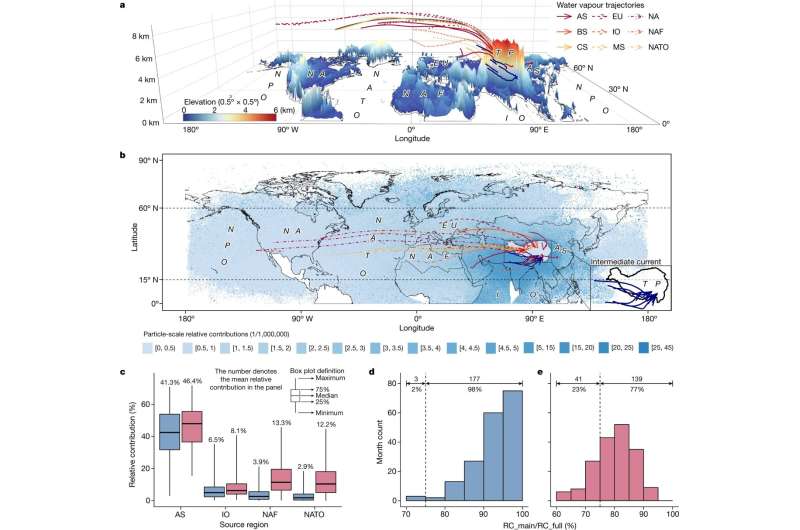Research reveals how climate change threatens Asia’s water tower
Tibet is known as the “Water Tower of Asia,” providing water to about 2 billion people and supporting critical ecosystems in High Mountain Asia and the Tibetan Plateau, where many of the largest Asian river systems originate. This region is also one of the areas most vulnerable to the compounding effects of climate change and human activities. Michigan State University researchers are identifying policy changes that need to happen now to prepare for the future impacts projected by climate models.
The rapid melting of glaciers and snowpack due to regional temperature increases has caused an unprecedented decline in water availability. This creates cascading impacts on water, food and energy security. MSU researchers also have found that the warming of the northern Atlantic and Indian oceans is exacerbating these issues, threatening water security in the region and interfering with the delicate balance of water in the atmosphere and its transport.
“It’s a global phenomenon,” said Yadu Pokhrel, associate professor in the College of Engineering at MSU. “The warming happening in the ocean changes how moisture originates and flows in different parts of the world, and that will directly impact the Asian water tower.”
Using climate models to predict future conditions combined with a model that tracks the source, movement and destination of moisture around the globe, Pokhrel and his team found that by the end of the century, 84% to 97% of High Mountain Asia and the Tibetan Plateau will experience a large water storage deficit. Increased warming reduces the amount of moisture in the region, which causes a continual decline of water availability.
“This is important because any changes to the water in this region—whether it is too little or too much water—impacts the economy and livelihood of millions of people in nearby countries,” Pokhrel said. “This can have huge global implications.”
For Pokhrel and the team, now is the time to act to prepare for the future. “We want to know what the overarching impacts of climate change are, how we can better understand the impacts on local communities and how we can develop adaptation strategies for the future.”
The research is published in the journal Nature.
More information:
Qiang Zhang et al, Oceanic climate changes threaten the sustainability of Asia’s water tower, Nature (2023). DOI: 10.1038/s41586-022-05643-8
Citation:
Research reveals how climate change threatens Asia’s water tower (2023, March 9)
retrieved 9 March 2023
from https://phys.org/news/2023-03-reveals-climate-threatens-asia-tower.html
This document is subject to copyright. Apart from any fair dealing for the purpose of private study or research, no
part may be reproduced without the written permission. The content is provided for information purposes only.

Tibet is known as the “Water Tower of Asia,” providing water to about 2 billion people and supporting critical ecosystems in High Mountain Asia and the Tibetan Plateau, where many of the largest Asian river systems originate. This region is also one of the areas most vulnerable to the compounding effects of climate change and human activities. Michigan State University researchers are identifying policy changes that need to happen now to prepare for the future impacts projected by climate models.
The rapid melting of glaciers and snowpack due to regional temperature increases has caused an unprecedented decline in water availability. This creates cascading impacts on water, food and energy security. MSU researchers also have found that the warming of the northern Atlantic and Indian oceans is exacerbating these issues, threatening water security in the region and interfering with the delicate balance of water in the atmosphere and its transport.
“It’s a global phenomenon,” said Yadu Pokhrel, associate professor in the College of Engineering at MSU. “The warming happening in the ocean changes how moisture originates and flows in different parts of the world, and that will directly impact the Asian water tower.”
Using climate models to predict future conditions combined with a model that tracks the source, movement and destination of moisture around the globe, Pokhrel and his team found that by the end of the century, 84% to 97% of High Mountain Asia and the Tibetan Plateau will experience a large water storage deficit. Increased warming reduces the amount of moisture in the region, which causes a continual decline of water availability.
“This is important because any changes to the water in this region—whether it is too little or too much water—impacts the economy and livelihood of millions of people in nearby countries,” Pokhrel said. “This can have huge global implications.”
For Pokhrel and the team, now is the time to act to prepare for the future. “We want to know what the overarching impacts of climate change are, how we can better understand the impacts on local communities and how we can develop adaptation strategies for the future.”
The research is published in the journal Nature.
More information:
Qiang Zhang et al, Oceanic climate changes threaten the sustainability of Asia’s water tower, Nature (2023). DOI: 10.1038/s41586-022-05643-8
Citation:
Research reveals how climate change threatens Asia’s water tower (2023, March 9)
retrieved 9 March 2023
from https://phys.org/news/2023-03-reveals-climate-threatens-asia-tower.html
This document is subject to copyright. Apart from any fair dealing for the purpose of private study or research, no
part may be reproduced without the written permission. The content is provided for information purposes only.
